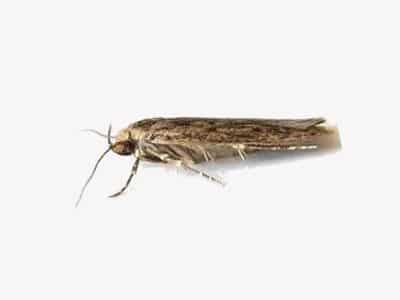About Case Bearing Clothes Moths
The case bearing clothes moth (Tinea pellionella) is a small moth species which is known for causing damage to natural fibres in clothing, carpets and textiles. This species is named for the portable cases larvae spun from textile material.
Textile damage is caused by the juvenile (larval) stages, so regularly seeing high numbers of these small, brownish-grey moths in your property indicates that damage to property has likely already been caused and may be ongoing.
These moths commonly infest clothing such as silk, cotton, wool and cashmere, carpets and rugs containing wool or natural fibres, pillows or duvets stuffed with feathers, fur coats and fur lined garments, and although not a primary source of food, leather goods made from animal hides can also be damaged by clothes moth larvae. As such, it is a notorious household pest species in the UK.
Pest Solutions are here to help with case bearing clothes moth problems. Get the details of your local Pest Solutions Branch here or call our national advice line on 0800 027 2555 to arrange a FREE survey or a service visit.
Identifying Case Bearing Clothes Moths
Adult case bearing clothes moths are typically 6-7mm long with brownish-grey colouring with distinctive darker patches on the wings. Adult moths will often be seen resting on walls close to infested textiles as well as on the textiles themselves.
Larvae are easily distinguished by presence of a portable protective casing which is spun from textile fragments. After hatching, near microscopic larvae begin to feed and grow, typically from 1mm-10mm however with the protective casing, can appear larger.
Signs of Case Bearing Clothes Moth Infestation
Unfortunately, in most cases, case bearing clothes moth infestations are not discovered until it is too late – damage has already occurred to fabric or textiles and may be ongoing.
If a case bearing clothes moth infestation is present within your property, you will likely notice these small, brownish-grey adult moths resting on walls in affected areas.
Clothing and textiles especially those with natural fibres such as silk, wool and cashmere should be inspected for irregular holes and small cylindrical cases shed from larvae, which indicates activity by case bearing clothes moths. Other than clothing, high risk items within your home are things such as pillows stuffed with feathers, carpets and curtains that contain wool or natural fibres.
Case bearing clothes moth larvae often seek dark places, meaning it can be difficult to locate damaged areas if they are behind or under furniture. Damage will often occur in areas that we do not see and can become extensive before the infestation is noticed.
Case Bearing Clothes Moth Biology & Lifecycle
The case bearing clothes moth goes through a complete metamorphosis which includes 4 life cycle stages: Egg, Larva, Pupa and Adult.
Adult case bearing clothes moths will lay clusters of eggs on a suitable textile, often in dark areas where they are difficult to detect such as along edges and in corners or seams. Usually within a few days, larvae will hatch and begin to feed immediately which causes damage to the textile in which they are present.
Depending on environmental conditions such as temperature and humidity, the larval stage can last from between 1 month and 2 years, meaning that a significant amount of damage to property can be done by these pests before adult stages emerge and are noticed.
Case-bearing clothes moth larvae will then spin cocoons and pupate for up to several weeks while developing into adults which will breed, lay eggs and continue the cycle of infestation. Adult case bearing clothes moths do no feed and usually die shortly after reproduction.
Case Bearing Clothes Moth Behaviour
The case bearing clothes moth is a common textile pest, regularly found infesting carpets, curtains, upholstery and clothing. Adult moths are harmless and will die shortly after reproduction. Females lay their eggs on a suitable textile with damage to fabric occurring from active feeding by larvae. Hundreds of eggs can be laid at one time.
Larval stages spin a portable case which provide protection as they feed and grow. When ready to pupate, this case is sealed, with an adult moth emerging shortly after, sometimes in as little as a week. Adult moths then breed, females will lay new eggs and the cycle of damage to property continues.
Risk of Case Bearing Clothes Moth Infestation
Infestation of case bearing clothes moths can cause extensive damage to clothing, carpets, upholstery and other textiles. This damage often goes unnoticed until it is too late.
There is a high risk of case bearing clothes moth activity in homes with natural fibres, especially older homes with hardwood flooring or abundant cracks, crevices or other harbourage points where dust and natural fibre particles can gather. These dark, inaccessible areas are ideal for common clothes moth larvae to feed and grow.
Significance of Controlling Case Bearing Clothes Moth
Infestations are likely to spread considerably through properties if the source of the infestation (sites where larvae are feeding) are not located and activity brought under control.
As case bearing clothes moth larvae can hatch in hundreds and begin to feed immediately, and larval stage potentially lasting months, it is easy to see how significant damage can be caused by these pests.
Once adults emerge, they will breed quickly within a few days. Females lay new eggs and soon the next generation of larvae will begin feeding causing more damage to property.
Controlling Case Bearing Clothes Moth Infestations
Getting rid of case bearing clothes moths can be difficult. In most cases, especially if the infestation is severe or long established, professional assistance is required.
If you find shed larval cases or irregular holes in clothing indicating that the has been case bearing clothes moth activity, hot washing affected items at 60°C will be effective to destroy all life stages including eggs, larvae and pupae.
What about wool, cashmere or silk? Most delicate garments made of these materials will not be suitable for hot washing. In these cases, freezing effected items can be effective to remove case bearing clothes moth larvae and eggs. Generally, this is effective after 72 hours at -8°C.
Vacuuming carpets regularly, including hard to reach areas, can remove eggs or larvae which could prevent the issue spreading any further. However, as case bearing clothes moth larvae tend to avoid light, they are often located in inaccessible areas such as between floorboards or under carpets or rugs. Remember to empty the hoover afterwards as moth larvae could continue to feed on natural fibres inside the hoover.
Insecticide treatments are also effective to get rid of case bearing clothes moths. Where suitable, insecticide treatments should be targeted towards areas where common clothes moth larvae are feeding. Professional expertise is often required to do this effectively.
Preventing Case Bearing Clothes Moth Infestations
Preventing case bearing clothes moth infestations in urban setting can be very difficult. Natural repellents such as cedar wood, lavender or old-fashioned moth balls can sometimes be effective deterrents to keep adult moths away.
Regular cleaning and inspection of textile storage areas, cupboard and wardrobes is recommended to reduce the risk of common clothes moth activity. Regular vacuuming of carpets can reduce risk of infestation.
However, in most cases, if adult moths are being seen in your property, it is too late for prevention and textiles have likely already been damaged.
DIY Pest Control
Can I get rid of case bearing clothes moths myself? For small scale infestations, cleaning effected textiles or clothing can be effective to remove common clothes moth infestations.
However, due to the light-avoiding nature of common clothes moth larvae, it is possible that larvae will remain elsewhere in your property, causing infestation to continue and enabling further damage to property or the woollen clothing in your closet. This ongoing damage can go unnoticed until adult moths emerge, and you realise that you still have a problem.
Amateur use insecticides or ‘moth killer’ applied to damaged carpets can sometimes be effective, but in most cases, a robust treatment plan involving cleaning, monitoring and several insecticide applications is necessary for complete eradication. Moth traps alone will do nothing to eradicate moth eggs or larvae, and will at best disrupt the adult moth life cycle. Depending on risk of infestation reoccurring, regular treatments may be required.
When to Call a Professional
A qualified pest management professional will be able to establish where case bearing clothes moths are coming from though thorough inspection and the use of pheromone monitors, and will recommend the best treatment plan including toxic and non toxic control measures for each situation.
Call Pest Solutions to Get Rid of That Pest Today!
Pest Solutions have local Branches across Scotland, England, Wales and Northern Ireland. Our expert local techs are at hand to attend today. Call now to get an experienced Pest technician visit and get that Pest problem under control swiftly.
Get the details of your local Pest Solutions Branch here or call our national advice line on 0800 027 2555 to arrange a FREE survey or a service visit.
Find out more about how to get rid of case bearing clothes moths.



















